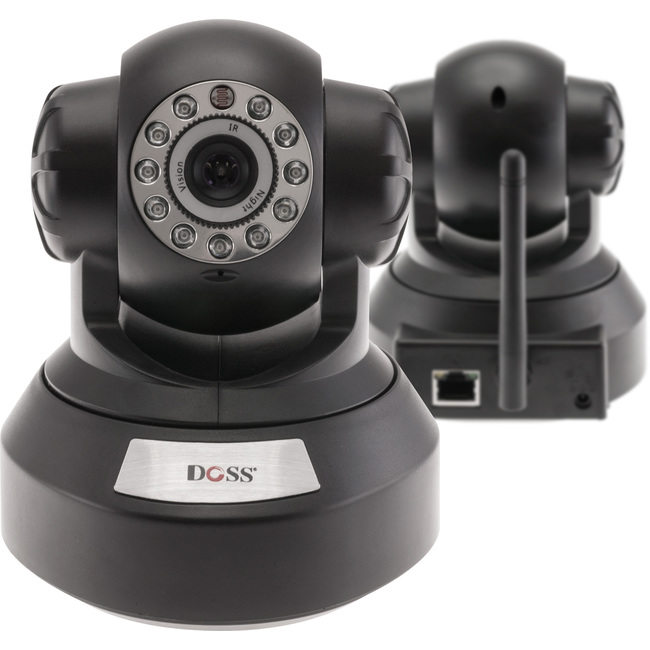Discontinued
The PT10QRECO Wireless IP Camera allows you to monitor your children from your iPhone/iPad or watch your pets while you’re out! With the ability to Pan and Tilt remotely, you can adjust the camera position to cover a much larger area than with a static camera alone.
Supplied with a handy QR-code, you can instantly be connected to your camera on your smartphone without the need for confusing DDNS and Port Forwarding configuration!
- Home Network IP Camera
- Ethernet and Wi-Fi connection options
- QR code instantly connects your smartphone to your camera anywhere in the world!
- Motion triggered Email and FTP notification
- Remotely pan and tilt camera view!
- VGA capture up to 30fps
- Talk-back feature
- Built-in microphone captures audio
- Audio output jack allows connection of external speaker (not included) for talk-back
- IR Night illumination up to 5m
| Image Capture |
Sensor |
CMOS sensor |
| Pixel count |
300k |
| Minimum illumination |
IR on, 0 Lux |
| Lens |
f=4.0 mm, F=2.0, Fixed Iris |
| Pan/Tilt |
Pan Coverage |
270° |
| Tilt Coverage |
120° |
| IR Illumination |
Lighting |
11x Infrared (850nm) LEDs, 5m distance |
| Lighting Control |
Auto control |
| Video and Audio |
Resolution |
640*480 (VGA) / 320*240 (QVGA) |
| Compression |
MJPEG |
| Frame rate |
30fps |
| Bit rate |
128kbps ~ 5Mbps |
| Image Rotation |
Mirror / Flip |
| Audio Compression |
ADPCM |
| Network |
Basic Protocol |
TCP/IP, UDP/IP, HTTP, SMTP, FTP,
DHCP, DDNS, UPNP, NTP |
| Network Interfaces |
10Base-T/100base-TX |
| 802.11b/g/n |
| Other Features |
Video control |
Yes |
| Dual way audio |
Yes |
| Motion Detection |
Yes |
| On-Trigger Actions |
Email / FTP |
| User Setting |
Three levels |
| Date / Time Setting |
Yes |
| Upgrade |
Upgrade from network |
| DDNS |
A free DDNS service provided by manufacturer |
| Hardware Interface |
Ethernet |
10Base-T/100base-TX |
| Audio In |
Internal mic |
| Audio Out |
Audio Line-out interface x1 |
| Physical |
Weight |
245g |
| Main body |
100mm(L)*99mm(W)*118mm(H) |
| Power |
DC 5V |
| Power consumption |
<6W |
| Operating temperature |
-20°C ~ 50°C |
| Operating humidity |
10% ~ 80% non-condensing |
| Software(PC Side) |
OS Supported |
Microsoft Windows XP/Windows 7 etc. |
| Browser |
Internet Explorer 6.0 and Above or Compatible Browser, Firefox, Safari etc. |
| Application Software |
IPCMonitor |
Connect camera with Ethernet and view with Smartphone
[Expand]
- Connect the camera to your router with the supplied Ethernet cable
- Connect the power to the camera
- While the boot-up sequence is taking place, download “IPCloud” iPhone or Android app to your smartphone
- You may need to side-load the Android app if you can’t find it. Use the .apk file found on the supplied software CD
- Wait for the self-test pan/tilt sequence to finish
- Load the IPCloud app
- Add a new camera:
- If your phone is connected to the same network as your PT10QRECO then you may already see it listed in the "Cameras Found" list—select the camera to add it.
- If no cameras are automatically found, or if your phone is not connected to the same network, simply press "QR Code" to scan the code on the bottom of the camera!
- Give the camera a name if you wish, eg: Lounge, Office, Deck etc and enter the password for the Camera (default password: 123456)
- Congratulations, you can now view your camera from anywhere in the world on your phone!
- You can pan/tilt by swiping the direction you want the camera to move.
Advanced settings:
- Load the IPCloud app on your smartphone.
- At the "Camera List" page, press the arrow marker for the camera you want to change the settings for
- You can rename your camera here, or fix the password if you have entered it incorrectly previously
- Press "Advanced Setting"
- Security Code — allows you to change the access password (recommended after first setup)
- Video Quality — improve picture at the cost of performance; reduce picture quality to gain performance
- Video Flip — adjust image orientation. Tip: Vertical and Horizontal flip is the same as rotating the image 180°
- Environmental Mode — flicker removal and night modes
- WiFi — more details on this are given in the next guide
Connect camera with Wi-Fi and view with Smartphone
[Expand]
If your router supports WPS, you can try the following steps (if it fails, or your router does not support WPS, see the steps below):
- Ensure your WiFi router is on and is ready to accept new devices.
- Ensure your camera is powered on and has finished the self-test sequence
- Press the WPS button on your Wireless Router
- Press the Reset button on the camera for 2-5 seconds
- Your camera should now connect to your WiFi network
- Download “IPCloud” iPhone or Android app to your smartphone
- You may need to side-load the Android app if you can’t find it. Use the .apk file found on the supplied software CD
- Wait for the self-test pan/tilt sequence to finish
- Load the IPCloud app
- Add a new camera:
- If your phone is connected to the same network as your PT10QRECO then you may already see it listed in the "Cameras Found" list—select the camera to add it.
- If no cameras are automatically found, or if your phone is not connected to the same network, simply press "QR Code" to scan the code on the bottom of the camera!
- Give the camera a name if you wish, eg: Lounge, Office, Deck etc and enter the password for the Camera (default password: 123456)
- Congratulations, you can now view your camera from anywhere in the world on your phone!
- You can pan/tilt by swiping the direction you want the camera to move.
If your Router does not support WPS or the above steps did not work you can configure the WiFi settings via Ethernet cable. You will have to complete the guide "Connect camera with Ethernet and view with Smartphone".
Once complete follow the next few steps:
- Be sure your WiFi router is on and can accept new connections
- At the "Camera List" page, press the arrow marker for the camera you want to add to your WiFi network
- Press "Advanced Setting"
- Press "WiFi"
- The camera will scan for a list of available WiFi networks to join
- Select your WiFi network, and enter the password if asked to do so
- Press Join once (there may be a delay before anything happens)
- Your camera should now be connected to your WiFi network
- Your camera may require a power-cycle (ie power off and on) for the WiFi settings to take effect
- You may now disconnect the ethernet cable from your camera and or position it anywhere in your home.
- Congratulations, you can now view your camera from anywhere in the world on your phone!
- You can pan/tilt by swiping the direction you want the camera to move.
Manage / view your camera via your PC
[Expand]
The following instructions assume you have already configured your camera’s network/Wi-Fi settings correctly and the PC you are trying to connect from is on the same network (subnet) as your camera.
If your computer is on the same network as your PT10QR, you will not have to configure any port forwarding but you will have to determine the IP address of your camera; this is easily done using the supplied LSearch software found on the supplied CD.
- Power up the camera and wait for the self-test to finish
- Load the "LSearch_en.exe" application and click "Search"
- If you do not find your camera, ensure the correct network adapter has been selected in the drop-down box under "Local PC Information"
- Alternatively check that your router has DHCP enabled
- Select your camera from the device list
- To view/manage your camera from your web-browser, click the "Browse" button
- You will be required to install QuickTime Player to view your camera in your browser
There is a wide range of settings available to you via the web-UI including the camera WiFi network setup, and Automatic Dynamic DNS host settings. You can access the camera’s settings via the settings button while viewing your camera in your browser.
To view your camera on a computer that is outside of your LAN (Local Area Network), you will have to setup Port Forwarding on your router connected to the internet. This is router dependant and we cannot support this process. Please seek advice from your router manual or manufacturer for information on this process.
If setting up Port Forwarding, the port you will require forwarded will be "Http Port" listed under "Device Information" in the LSearch software. If you have multiple cameras you may wish to manually set the port for each camera to be unique. To change the Http Port of a camera:
- Power up the camera and wait for the self-test to finish
- Load the "LSearch_en.exe" application and click "Search"
- Select the camera you wish to change the port for
- Change the Http Port by typing it in, or clicking the up/down buttons
- Enter your account details (default user: admin, default password: 123456)
- Click Update—your camera will now restart with the new settings applied (you may lose access if you had a browser window already open and old bookmarks/links may need to be updated with the new port number)
DOSS Security Training 2013

Watch the training series on our new CCTV Cameras for 2013 here!
What you need to know for new CCTV installations
Cameras
- What does each camera need to see? i.e. how far, how wide, how much detail?
- What are the conditions the camera needs to work in? i.e. Day or night, infra-red, indoor or outdoor?
- How will it be mounted, and are there any style considerations?
DVRs
- How many cameras does it need to monitor, allowing for any expansion?
- Do you need full D1 (576 line) recording on all channels?
- How many days of recording at what quality needs to be stored?
Cabling
- Do you want to run coaxial + power, or CAT5E/CAT6 with baluns?
Power
- Will you supply power locally to each camera, or have one central supply?
- What size of UPS do they need?
- Do you want a plug pack, wall box (needs an electrician to wire), rack-mounted supply, or power supply + video balun box in one?
Networking & Remote Access
- Does your customer want to view their cameras remotely?



